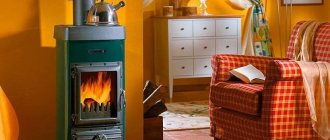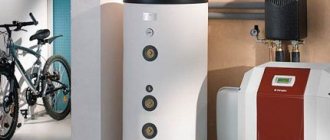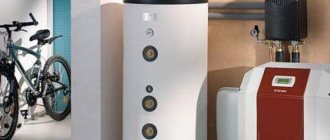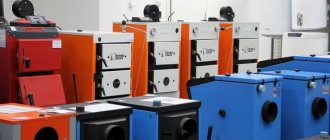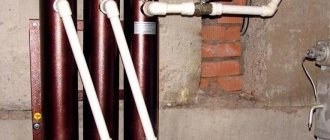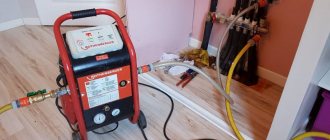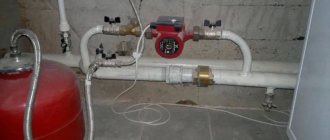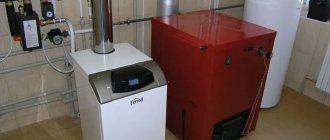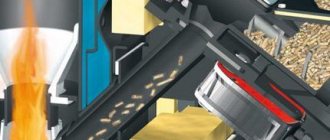Many visitors to the Technodom online store contact us with a request to select heating boilers online. We are always ready to help them in this matter, especially since our company’s range includes many different types and models of equipment suitable for literally any purpose. For example, if you need to select a gas boiler based on its parameters, our consultants will be happy to provide you with all the necessary information. Before you start choosing heating equipment, it is advisable to determine which criteria will be most important for you.
What to look for when choosing a boiler
To make the right choice of heating boiler for a private home, it is worth considering several fundamental points.
First of all, you should pay attention to the types of fuel available in a particular region. Both the cost of fuel and the ability to easily purchase it if necessary will matter.
The next important point is the presence of automation, that is, the ability to work without operator intervention. This condition becomes especially relevant if there is no one in the house during the day, and the equipment must work continuously.
When selecting a heating boiler, you need to consider how simple and easy to use this or that option is, as well as what kind of maintenance it requires. If you do not want to regularly clean the boiler, then it is better to opt for an automated product, although it will cost significantly more.
It is worth noting that all solid fuel boilers require periodic cleaning of burners and combustion chambers. Gas and electric appliances require much less maintenance.
Gas boiler options
All gas heating appliances differ primarily in the type of installation - they can be floor-mounted or wall-mounted. Wall-mounted boilers are designed for a maximum power of 60 kW, but floor-standing appliances produce a power of 100 kW or more. Some boiler models are designed to operate in cascade. It is worth noting that one of the advantages of wall-mounted boilers is their compactness - they can easily fit into the interior of the kitchen.
If you plan to install a floor-standing boiler with a power of more than 60 kW, you will have to allocate a separate room for it. It can be placed either in the house itself or attached to it and have a separate entrance.
It is not always possible to connect directly to the main gas pipeline, however, this is not a reason to refuse to install a gas boiler. In this case, you can select a gas boiler according to the parameters of your home, equipping it with a special burner for working with liquefied gas. How economically profitable such an output will be can only be determined after preliminary calculations. To do this, you need to calculate how much 1 kW of heat will cost if you use several alternative available fuels.
How much heat can be obtained from different types of fuel.
Depending on the type of heating boiler you choose, you will incur costs not only for creating a heating system, but also constant costs for fuel. We will look at what these costs will be in the following sections.
Natural gas.
One of the most popular and economical types of fuel. When burning 1 cubic. meters you can get up to 9.3 kW of thermal energy or 8,000 kcal. (without taking into account the energy of the phase transition of water vapor). Qnr=8.2…9.2 kW/N.m3. The efficiency of combustion in a conventional boiler is 85-90%. The total efficiency when burning in a condensing boiler is 110-115%. The average price of gas in the Republic of Belarus as of May 1, 2017 is 0.118 BYN. rub. for 1 cubic meter. This means that in order to get 100 kW of heat, we must spend only 1.26 rubles.
Liquefied gas.
The fuel is quite expensive and can be used when it is necessary to heat a dacha or for temporary heating during the planned transition to natural gas in the near future. Unit of measurement - l. or kg. Qнр=6.8 kW/l or 12.8 kW/kg (density 530 kg/m3, excluding the phase transition energy of water vapor). The efficiency of combustion in a conventional boiler is 85-90%. Cost 1 kg. liquefied gas approximately 0.5404 bel. ruble This means that in order to get 100 kW of heat, we must spend 4.22 rubles, i.e. 3.5 times more than when using natural gas for heating a home.
Diesel fuel.
Even more expensive fuel and rarely used in heating boilers. Unit of measurement - l. Qнр=10.2 kW/l (density 860 kg/m3, excluding the energy of the phase transition of water vapor). The efficiency when burned in a conventional boiler with a liquid fuel burner is 85-90%. The cost in the Republic of Belarus as of May 1, 2017 is 1.27 BYN. rub. for 1 liter. This means that in order to get 100 kW of heat, we must spend 12.45 rubles, i.e. 10 times more than when using natural gas to heat a home.
Firewood.
The unit of measurement is kg or m3. It should be noted that the heat released during the combustion of wood is very dependent on the moisture content of the wood. The fresher the wood you use, the higher its humidity and the less heat you will receive. In addition, the heat of combustion also depends on the type of wood. The most commonly used firewood is pine and birch. Average dryness of firewood can be considered with the following calorific value - Qнр = 3 kW/kg or 1421 kW/m3 (density 480 kg/m3, humidity 30%, excluding the phase transition energy of water vapor). The efficiency when burning in a solid fuel boiler is 65-80%. The average cost is 50 rubles per 1 cubic meter. Taking into account the low efficiency of wood-burning boilers, we can calculate that in order to get 100 kW of heat, we must spend about 3.5 rubles, i.e. 3 times more than when using natural gas to heat a home.
Pellets.
A modern type of fuel for pellet boilers, which allows you to create a relatively autonomous heating system. Unit of measurement is kg. The calorific value depends on the manufacturer and on average will be equal to Qнр = 4.2 kW/kg (density 680 kg/m3, humidity 10%, excluding the phase transition energy of water vapor). The efficiency when burning in a pellet boiler is 70-80%. The average cost is 0.3 rubles per 1 kg. Taking into account the low efficiency of pellet boilers, we can calculate that in order to get 100 kW of heat, we must spend about 7.14 rubles, i.e. 5 times more than when using natural gas to heat a home.
Electricity.
A fairly affordable type of fuel. Modern electric heating boilers have high efficiency and reduce home heating costs. The unit of measurement is kWh. Qnr= 1 kW. The efficiency of electric boilers is 98-99%. The average cost is 0.12 rubles/1 kWh. You can calculate that in order to get 100 kW of heat, we must spend about 12 rubles, i.e. 10 times more than when using natural gas to heat a home.
Calculations show that the most economical type of fuel in our country is natural gas and firewood. The most expensive fuels are electricity, diesel and pellets.
So, in order to select and buy a boiler for heating your home, you need to find out about the possibility of laying a natural gas line to your home. If possible, it is better to choose a gas boiler. If gas tariffs rise and the cost of electricity falls, then perhaps, as in Europe, a transition to heating with an electric boiler is possible in the future.
Types of burners
There are two main types of burners - open (or atmospheric) and closed (turbocharged). Atmospheric burners require a chimney with good draft, while turbocharged burners are connected to a coaxial chimney that passes through the wall near the boiler.
When choosing a gas boiler based on parameters, you should pay attention to the combustion chambers for different burners. They differ in the method of air intake. An open-type burner sucks air directly from the combustion room, which is why it is necessary to install powerful supply ventilation. But for turbocharged burners, the fuel chamber is supplied by one of the pipes of the coaxial chimney. In this case, there are no strict requirements regarding ventilation.
It is worth noting that one of the disadvantages of boilers with a turbocharged burner is the sensitivity of the chimney to atmospheric phenomena - frost or heavy snowfall. In this case, the boiler simply will not turn on.
Another fundamental point is that it is advisable to select a gas boiler according to the parameters of the burner, that is, how many modes it is designed for.
There are three options:
- Single stage . Such a boiler has only two operating modes - on at full power and off. This is the cheapest type of burner and consumes too much gas. This type of boiler cannot be called energy efficient.
- Two-stage . The burner can be set to operate at 50% or 100% power. The third mode is complete shutdown. This is a more economical option for boilers that allow you to maintain the temperature in the room to one degree or another.
- Modulated . The most effective, but also expensive option. Smooth adjustment of the power level allows you to turn on the boiler at both 10% and 100%.
Of course, when choosing a heating boiler based on burner type, it is most reasonable to choose a modulating option. Excessive costs during purchase will quickly pay for themselves during operation.
Selection of an electric heating boiler
In addition to selecting a gas boiler for a private home according to its parameters, our clients are also interested in other types of these devices. For example, electric models are very popular. Such boilers must be selected according to their power (this is a universal parameter for any model), type of connection (220V or 380V), principle of power control (stepped or smooth), as well as heating method (heating element or electrode). Each of the listed criteria can play a rather important role, therefore, we recommend paying increased attention to all of them.
Condensing type gas boilers
The gas boilers described above are high-temperature appliances, the coolant temperature at the outlet of which is 45-50 ℃ and even more. They are ideal for installing radiators.
The special feature of condensing boilers is that they can operate efficiently with temperatures of no more than 40℃ in the return pipe. In this case, economical consumption of gas is achieved, since heat is transferred to the coolant due to the condensation of hot steam contained in the flue gases.
This type of boiler is ideal for heating a house with a warm water floor. As a rule, the coolant temperature at the boiler outlet is 35 ℃, and in the return circuit it is about 30 ℃. This operating scheme makes the boiler economical and energy efficient.
Note that condensing boilers also have some disadvantages. First of all, this is a very caustic condensate. In this regard, a very high-quality stainless steel chimney is required. In addition, if you select a boiler based on power parameters, the price of condensing devices will be much higher than that of similar devices of the traditional type. The higher cost is due to the rather complex operation scheme, as well as the use of high-quality, condensate-resistant materials.
How to calculate the power of a heating boiler
The cost of a gas boiler is directly proportional to its power. And this is where we are faced with a dilemma. On the one hand, you want to have equipment with a power reserve so that you don’t freeze in your own home on particularly cold winter days, on the other hand, you really don’t want to overpay. How not to make a mistake when choosing a gas boiler based on this parameter?
Of course, specialists are best able to handle this issue. However, you can make a preliminary assessment of the power of climate control equipment you need yourself. To do this, it will be enough to use the “Ten to One” rule.
According to this rule, derived empirically, heating 10 square meters of space requires 1 kW of thermal energy. For example, for a house with an area of 100 sq.m. you will need a 10 kW boiler. It is assumed that the house is well insulated, the ceiling height does not exceed 3 meters, and the temperature outside is kept within the range of –25…–30°C.
Accordingly, if you live in a region characterized by harsher winters or the quality of home insulation leaves much to be desired, the boiler power calculated using this formula will not be enough. An experienced engineer will take all these nuances into account when developing a project. If you want to do the calculation yourself, just allow a power reserve of 10-20 percent.
It should be taken into account that these calculations are only suitable for single-circuit boilers that provide heating for the house. If you plan to install a double-circuit boiler that will not only warm your home, but also prepare water for hot water supply, then the power of this unit should be significantly higher.
In order for the boiler to be able to produce 10 liters of water per minute at a temperature of 35°C, which is enough for a comfortable shower, its power must be at least 24 kW. If there are two water points in the house, the lower limit of the required power will rise to 28-30 kW. If your house has two kitchens, three bathrooms and many household members, it makes sense to think about installing two gas boilers.
Types of electric boilers
When selecting the power of a heating boiler according to the area of the house, it is worth understanding the main types of such devices:
- heating elements . This is the traditional and most common version of electric boilers. Multi-stage units are considered more economical, since they are capable of operating in several modes. Among the disadvantages is low efficiency due to heat loss for heating heating elements. But the advantages include low prices for consumables (heating elements) and easy repairs.
- Induction . In such equipment, the coolant is heated at the moment water passes through the inductive coil. It is believed that induction boilers are more economical compared to heating elements, they have no heat loss and virtually no inertia. In addition, such boilers are very compact - they look like a piece of pipe from 35 cm to 1 m long. Among the disadvantages is the need for constant circulation of the coolant, otherwise the boilers overheat and burn out quickly.
- Electrode . Many buyers, when they want to choose a boiler according to its parameters, choose this type of equipment the least often. Although they are considered the most economical, in most cases consumers are stopped by the need to circulate electrolyte through the pipes as a coolant, that is, water with certain additives. This requirement is due to the fact that heating of the coolant occurs due to the passage of current between the electrodes. When operating boilers of this type, it is necessary to monitor the condition of the electrodes and electrolyte. In addition, the entire installation operates under voltage - this also somewhat frightens consumers.
Thus, if you don’t know how to choose a boiler based on the area of your house and which option to choose, then pay attention to induction and heating elements products.
Solid fuel boilers
Often, when selecting a heating boiler based on area, consumers choose solid fuel equipment. Although it has a number of disadvantages, it is still the most popular.
As a rule, coal and firewood are used to fire solid fuel boilers. The final choice depends on which raw materials are more available in a given region. It is worth noting that coal and wood boilers differ from each other. Wood-burning boilers have a large loading chamber that can hold a lot of firewood. Coal chambers have a smaller firebox with thicker walls to withstand high combustion temperatures.
The advantages of solid fuel boilers are:
- saving money on heating;
- reliability and prostate structure;
- ability to work regardless of the availability of electricity.
It is worth mentioning significant disadvantages:
- Due to the cyclical operation of boilers, the air temperature in the house is not constant, it becomes either cold or hot. To solve this problem, heat accumulators are installed, that is, containers with water, which allow you to maintain an optimal microclimate constantly - during the combustion process, heat is accumulated, which is then used to warm up the house.
- Need for maintenance. Any solid fuel will first have to be loaded, ignited, the intensity of its combustion must be monitored, and upon completion of the process, the firebox must be cleaned and the boiler re-ignited.
- The system cannot work offline. As it burns out, it is necessary to periodically add a new portion of fuel so that the system does not freeze.
- Since a lot of dirt is formed during the process of filling fuel and cleaning the boiler, it is advisable to install the boiler as close to the entrance as possible so as not to spread it everywhere.
In general, a solid fuel boiler in the heating system of a private house does not seem very convenient. Despite the fact that fuel for them can be easily obtained and is relatively cheap, it takes a lot of time to kindle, so the savings are not always justified.
Installation of a gas heating boiler
All gas boilers, regardless of their level of sophistication, have the same operating principle and a similar design. Let's figure out what's hidden under the body panel of any gas boiler.
Main structural elements of a gas boiler
1. exhaust gas removal; 2. air blower; 3. heat exchanger;
4. combustion chamber; 5. burner; 6. DHW heat exchanger;
7. circulation pump; 8. gas valve; 9. control unit.
Burner
The burner can safely be called the heart of a gas boiler. This is where fuel combustion occurs, releasing thermal energy. According to the method of regulating the flame intensity, burners are divided into:
- single stage;
- two-stage;
- modulated.
The former have only one operating mode, the latter have two (maximum and economical), while the latter have power that can be smoothly adjusted in a fairly wide range from 10 to 100%, which makes it possible to fine-tune.
Modulating burners are much more convenient to use, allow you to maintain the set temperature with minimal deviations and provide fuel savings. For these reasons, most gas boilers produced today are equipped with just such burners.
According to the method of igniting the gas-air mixture, all burners can be divided into devices with manual ignition (piezo ignition) and automatic ones. The former can be found only in the simplest and cheapest boilers. Modern gas boilers are designed to heat a house in autonomous mode: their operation is controlled automatically, and it is impractical to install burners with manual ignition on them.
For those who choose a gas boiler, it is important to know that main (natural) gas and liquefied propane-butane mixture supplied in cylinders require different burners. In some boiler models, but not all, it is possible to replace the nozzle with one suitable for a different type of gas.
Gas boiler burner with fittings and automation.
The combustion chamber
The combustion chamber in which the burner is located can be closed or open. An open combustion chamber consumes air from the room, while a closed combustion chamber requires additional installation of a special air intake.
Gas fittings
Gas fittings are designed to regulate the gas supply to the burner. Based on a signal received from the control unit, the valve opens or closes, blocking the movement of gas through the supply pipes of the gas pipeline.
Three-way valve
A three-way valve is used in double-circuit gas boilers. It switches the system to the mode of generating hot water for domestic hot water and back to the heating mode. The valve is activated when the water tap opens/closes.
Chimney
The chimney is designed to remove combustion products. The smoke removal system can be either forced or natural draft.
Heat exchanger
The heat exchanger performs the function of transferring the heat released during gas combustion to the coolant. In its simplest form, it is a coil through which the heating system coolant moves, with many tightly packed metal plates.
The longer the coil pipe and the greater the number of plates mounted on it, the greater the heat transfer. The material from which the heat exchanger is made is determined primarily by the method of installation of the gas boiler. In wall-mounted devices, as a rule, copper or stainless steel are used for these purposes - relatively light metals.
Steel heat exchanger of a gas boiler.
In floor-standing models, heavy cast iron heat exchangers are often installed, since cast iron is less susceptible to corrosion (and therefore has great durability) and retains heat well. In addition to the main heat exchanger located above the burner, some gas boilers install an additional one designed to heat water for the hot water system.
Cast iron gas boiler heat exchanger.
Circulation pump
The circulation pump forces the coolant to continuously move through the pipes of the heating system. Thanks to the pump, heat is distributed faster throughout all rooms of the house.
Expansion tank
The expansion tank is designed to compensate for the increase in the volume of liquid that acts as a coolant when it is heated. The volume of the tank depends primarily on the volume of coolant in the heating system (~10% of the volume of the total liquid). The tank is located either in the body of the boiler itself, or in close proximity to it.
Security system
The safety system includes a pressure gauge, safety valve and air vent. The pressure gauge monitors the pressure in the system. If it “exceeds” the upper limit of permissible values (according to Russian standards - 3 bar), the safety valve will reset. An air vent is needed to remove air from the system, which is always dissolved in some quantity in both water and antifreeze and which, as the temperature rises, begins to come out of the liquid in the form of bubbles.
Control block
The control unit carries out the function of monitoring the state of various components of the system and controlling the burner, circulation pump, valves and other elements. Electronics, through various sensors, monitors the temperature in the rooms and in the heating system circuits, coolant pressure, presence of flame and other process parameters. The simplest control unit ensures that the temperature specified by the user is maintained.
In more complex and expensive models, it can be programmed for various boiler operating modes (for example, a slight decrease in temperature at night, “master at work” mode, when during the entire working week the boiler maintains a low temperature during the day, and only reaches full power in the evening, i.e. by the time the residents return home, the “owner is away” mode, in which the temperature in the premises is maintained at the minimum acceptable level, preventing the coolant from freezing in the pipes, etc.).
When installing temperature sensors outside the building, the control unit can force the boiler to operate even in weather-dependent mode, which allows significant fuel savings. If an emergency occurs, the automation will automatically turn off all equipment.
Even relatively simple boilers have the ability to connect the control unit to the remote control. More complex models can also be controlled via a GSM channel. Of course, the “smarter” a gas boiler is, the more expensive it is, but the high cost is justified by increased efficiency and operating comfort.
Heating devices operating in long-burning mode
Long-burning boilers have been designed to maximize combustion efficiency and the time between loads.
There are two options for such equipment.
- Pyrolysis boilers . Such devices have two or even three combustion chambers. In this case, fuel combustion occurs with a lack of oxygen. As a result, a large volume of flue gases is released, most of them very flammable. These gases enter the next chamber, into which air is supplied. When mixed with oxygen, flammable gases ignite again and produce even more heat than the solid fuel itself.
- Devices with top combustion type . In conventional solid fuel boilers, combustion propagates from bottom to top, that is, most of the load is burned at the same time. Due to too intense combustion, the system quickly overheats, which is not very effective and is uncomfortable for residents. If the top combustion principle is applied, then ignition is carried out only in the upper part of the loaded fuel. In this case, only a small part of them lights up, which significantly extends the combustion life of the fuel. Thus, the temperature in the room is equalized.
The efficiency of long-burning solid fuel boilers is quite high - various designs with wood can operate from 6-8 hours to a day on one load, and with coal - from 10-12 hours to several days. However, such results can only be achieved if very high-quality fuel materials are available. The main thing is that they are dry. Wet coal or firewood will not even be able to smolder, that is, such a boiler will not warm. It is advisable to equip a coal storage shed or wood shed with a supply of 2-3 years. In this case, a long-burning solid fuel boiler will truly be a worthy choice.
TOP 5 gas boilers
Buderus Logamax UO72-24K 24 kW
The geyser is equipped with functions of auto-diagnosis, frost protection, flame modulation, pump blocking protection, auto-ignition, etc..
You don't have to worry about danger with the gas control system, safety valve and air vent. Boiler weight - 31 g, dimensions - 400 * 700 * 299 mm.
Specifications:
- type of boiler - gas, convection;
- burner type - gas;
- number of circuits - two;
- power - 7.20-24 kW;
- heat load - 8-26.70 kW;
- combustion chamber type - closed;
- Efficiency - 92%;
- regulation - electronic;
- placement - wall;
- primary heat exchanger material - copper;
- mains voltage is single-phase;
- circulation pump - yes;
- expansion tank - yes, 6 l;
- fuel - natural and liquefied gas;
- natural fuel consumption - 2.8 cubic meters. m/hour;
- liquefied fuel consumption - 2 kg/hour;
- natural fuel pressure - 10.50-16 mbar;
- liquefied gas pressure - 35 mbar;
- hot water productivity at a temperature of 30 degrees - 11.4 l/min;
- maximum water pressure in the hot water supply circuit - 10 bar;
- The maximum water pressure in the heating circuit is 3 bar.
Advantages:
- good price;
- high-quality assembly;
- holds temperature well.
Flaws:
- not very clear controls;
- boards do not work well due to voltage surges.
Lemax Premium-10 10 kW
The gas boiler has overheating protection functions and a thermometer. Equipped with a gas control security system. Product weight - 41 kg, dimensions - 330*784*499 mm.
Specifications:
- type of boiler - gas, convection;
- burner type - gas;
- number of circuits - one;
- power - 10 kW;
- combustion chamber type - open;
- Efficiency - 90%;
- regulation - mechanical;
- placement - floor;
- primary heat exchanger material - steel;;
- fuel - natural gas;
- consumption of natural fuel - 1.2 cubic meters. m/hour;
- natural fuel pressure - 13 mbar;
- maximum water pressure in the hot water supply circuit - 1 bar;
- maximum coolant temperature - 90 degrees
Advantages:
- acceptable price;
- compact dimensions;
- good efficiency;
- efficiency.
Flaws:
- there is condensation;
- Sensors and thermometers cannot be connected.
Lemax Premium-20 20 kW
Gas boiler capable of heating a room up to 200 sq.m. It has overheating protection, a thermometer and a gas control function. The model can include functions of self-diagnosis, frost protection, auto-ignition, etc.
Specifications:
- type of boiler - gas, convection;
- burner type - gas;
- number of circuits - one;
- power - 20 kW;
- combustion chamber type - open;
- Efficiency - 90%;
- regulation - mechanical;
- placement - floor;
- primary heat exchanger material - steel;
- fuel - natural gas;
- natural fuel consumption - 2.4 cubic meters. m/hour;
- natural fuel pressure - 13 mbar;
- The maximum water pressure in the heating circuit is 3 bar.
Advantages:
- good price;
- easy to operate;
- silent.
Flaws:
- heat exchanger made of steel.
Leberg Flamme 24 ASD 20 kW
The wall-mounted boiler runs on natural gas, ignition is automatic. The model is characterized by high performance and long service life.
Specifications:
- type of boiler - gas, convection;
- burner type - gas;
- number of circuits - two;
- power - 20 kW;
- combustion chamber type - closed;
- Efficiency - 96.1%;
- regulation - electronic;
- placement - wall;
- mains voltage is single-phase;
- circulation pump - yes;
- expansion tank - yes, 6 l;
- fuel - natural and liquefied gas;
- natural fuel pressure - 20 mbar;
- hot water productivity at a temperature of 25 degrees - 12.7 l/min;
- maximum water pressure in the hot water supply circuit - 6 bar;
- maximum water pressure in the heating circuit - 3 bar
Advantages:
- made of high quality, from good metal - brass;
- good price;
- convenient functionality;
- compact dimensions;
- warms well.
Flaws:
- There are problems with circulation.
MORA-TOP Meteor Plus PK24KT 23 kW
Gas boiler for heating residential premises. Equipped with electronic sensors for measuring water temperature and a gas control system.
Specifications:
- type of boiler - gas, convection;
- burner type - gas;
- number of circuits - two;
- power - 8.90-23 kW;
- heat load - 10.50-25.50 kW;
- combustion chamber type - closed;
- Efficiency - 90%;
- regulation - electronic;
- placement - wall;
- mains voltage is single-phase;
- expansion tank - yes, 6 l;
- fuel - natural gas;
- natural fuel consumption - 2.67 cubic meters. m/hour;;
- natural fuel pressure - 13-20 mbar;
- hot water productivity at a temperature of 30 degrees - 11.2 l/min;
- maximum water pressure in the hot water supply circuit - 6 bar;
- maximum water pressure in the heating circuit - 3 bar
Advantages:
- economical;
- electronic control with display;
- built-in circulation pump;
- auto-ignition and auto-diagnosis.
Flaws:
- high price.
Liquid fuel equipment
It is worth noting that when selecting a boiler by area, liquid fuel equipment is rarely preferred.
The low popularity of such boilers is due to the following factors:
- high price of fuel;
- the need for a place to store diesel fuel, that is, a large container located close to the house;
- the need to provide heating for the tank so that diesel fuel does not thicken at low temperatures and clog the burner;
- Since the operation of the equipment is accompanied by a high level of noise and an unpleasant odor, it must be installed either in a well-ventilated extension or in a separate boiler room.
In this regard, it is advisable to install an oil-fuel boiler only if you have constant access to cheap fuel.
Determining the thermal power of the boiler
Surely you know the popular methods for calculating the thermal performance of equipment - by area or volume of heated premises. Allegedly, for a dwelling of 100 square meters a 10 kW boiler is taken, for a country house of 200 square meters. m – unit 20 kW.
It is better not to use these approximate methods, since specific conditions are not taken into account - the climate in the area of residence, the degree of thermal insulation of the building, and so on. We suggest using more accurate calculation methods:
- According to the specific heat load per square square of living space, taking into account the location of the room and the number of window openings.
- The same goes for the volume of premises.
- Full calculation using the SNiP formula, taking into account the thickness and thermal insulation of external building structures.
An example of calculating heat loss by area, taking into account the location of rooms and the number of window openings
Comment. All 3 methods are described in detail in a separate guide to calculating the heat load for heating a residential building.
Knowing the heat consumption for heating the cottage, we select a gas boiler based on power as follows:
- if you plan to use the unit only for heating, multiply the resulting figure by a safety factor of 1.2;
- the power of a 2-circuit heat generator providing 2 water draw-off points is best selected with a margin of 1.3-1.5;
- To work with an indirect heating boiler with a volume of 200-300 liters, you will need a gas single-circuit boiler with one and a half capacity reserve (multiply by a factor of 1.5).
Let's give an example. For heating a private home with an area of 100 square meters. m is calculated to require 9 kW of energy. The minimum power of a gas heater excluding DHW will be 9 x 1.2 = 10.8 kW, a double-circuit boiler - 9 x 1.3 = 11.7 kW. If you need to heat the storage tank, the unit’s performance increases to 9 x 1.5 = 13.5 kW. Next, we select the nearest higher-power model from the line of heaters - 12 and 15 kW, respectively.
Pellet boilers for home
Due to the design features of pellet boilers, they are classified as a separate class. The fuel for such devices is sawdust compressed into granules. As a rule, a special shed or bunker is allocated for storing pellets near the boiler. The length of independent operation of the equipment depends on the size of such a bunker. Typically, about two buckets of pellets are required per day of work.
A special burner is installed in a pellet boiler, which allows you to burn fuel almost completely. If the granules are of high quality, then about 3-5% of ash is formed as a result of combustion. Therefore, cleaning the firebox is required only once a week or even several weeks. Thanks to the automation of the equipment, it can work autonomously for several weeks.
Among the disadvantages of modern pellet boilers are the high price and sensitivity to fuel quality. Pellets must be durable, not crumble or break, have low ash content and good calorific value.
In general, when selecting a boiler based on the area of the house, a pellet appliance can be a good option if there is enough fuel for it.
Combined type devices
Before you choose the boiler power for your home, you should pay attention to another type of boiler - combination boilers. This refers to devices that can operate with several fuel options. Most often, consumers purchase solid fuel boilers with built-in heating elements. At the moment of combustion of coal or wood, the system warms up in the same way as when using a conventional solid fuel boiler. When the fuel burns out and the boiler begins to cool, electric heating elements are turned on to maintain the temperature in the house. By themselves, they are not capable of fully heating a house, but they are quite capable of maintaining the temperature and preventing the system from freezing.
Combination boilers with burners for liquid fuel are in fairly high demand. Such devices are equipped with two separate combustion chambers - for solid fuel and for liquid.
Despite all the advantages of such devices, they also have disadvantages. First of all, the price is high. In addition, the efficiency of each section of the boiler is at an average level. Thus, it is difficult to unambiguously assess the feasibility of this type of boiler.
Selecting a heating boiler
Considering the wide variety of heating devices on the market, many consumers do not know how to choose the power of a heating boiler and which type to choose.
Here are the basic requirements for such devices:
- Saving money . The optimal types of fuel are wood, coal and natural gas. At the next level in terms of cost are pellets, liquid fuel and electricity. However, it is worth taking into account the specific situation in each region and the availability of a particular type of fuel.
- Autonomy . Gas, pellet and electric boilers can operate without operator intervention. Such devices do not require constant supervision. Some control is necessary on oil boilers. But solid fuel ones have a minimal level of automation.
- Easy to connect . The most problematic is the process of designing and connecting a gas boiler to the main pipeline. If there is an electric boiler, the substation must allocate a powerful heating line if they have a reserve. All other equipment is connected much easier, but in compliance with safety measures.
Thus, taking these factors into account, it will be much easier for you to decide on the type and power of the boiler for your private home.
Selection of boilers and boiler equipment
Home » Selection of boilers
Advantages of heating boilers offered on the RussKotel website.
First of all, this is the use of high-quality steel. This steel is durable and resistant to corrosion. The steel used in heating boilers makes it possible to design heating systems for many years without the suspicion of replacing heating equipment.
The second is environmental safety. You can absolutely safely use our boiler units in apartments, houses and other residential premises, because There is no solvent in the heating element, which allows heating boilers safe equipment. The scientific institute has given the highest degree of safety to our boilers, because When fuel burns, a small amount of NOX is released.
The initial task facing the consumer is choosing a heating boiler. Nowadays, heating costs make up a significant part of the costs associated with the operation of a country house, cottage, cottage or bathhouse. When choosing the optimal type of fuel and, accordingly, the heating system, it is also necessary to take into account self-sufficiency, if possible.
As we wrote earlier, depending on the type of fuel used, boilers are: liquid fuel, solid fuel, gas, and combined.
Let's start with solid fuel - it is always cheaper if you do not take into account the cost of your own labor, room pollution and non-standard installation of the heating system. Coal is unrivaled in cases where time costs do not matter. Coke is more convenient than ordinary coal for continuous combustion furnaces.
Liquid fuel - oil and petroleum products - are more expensive fuel. But one of the disadvantages of liquid fuel is the need to have a storage facility that can accommodate all the amount of fuel required for the winter. If you place a fuel tank in the basement, the latter cannot be used for other purposes. The tank can also be placed in the yard by burying it in the ground.
Of course, gas is always more convenient than any other fuel. Well, firstly, it is affordable, secondly, it does not require any storage tanks, and thirdly, there is no need for additional costs on your own labor. The only BUT is the lack of gas supply in your locality or your street. If there is a natural gas network in the area, then it is of course more advisable to use gas heating. If you plan to gasify your area soon, then you need to install a combined heating boiler that can temporarily operate on liquid fuel, and then switch to gas without major reconstruction.
In turn, boiler units are: conventional condensing and condensing pulsating combustion boilers. The principle of a condensing boiler is based on the use of heat, which is released by water vapor during condensation. This heat, thanks to the special design of the boiler, is also used to heat the coolant. Due to this, the efficiency of condensing boilers is 30-40% greater than that of conventional boilers. A pulsating combustion condensing boiler differs from conventional condensing boilers in that heat is produced by micro combustion (115 per second). The air-gas mixture enters directly into the combustion chamber and produces micro-ignitions, i.e. The principle is similar to the operation of an internal combustion engine.
Our experts recommend buying conventional condensing boilers; moreover, they are well suited for underfloor heating systems, during which the water temperature in the system can be below 60 degrees, so with a floor heating system, a condensing boiler can be used all year round.
To choose an economical type of fuel, you cannot rely only on installation costs; you must also take into account long-term costs. Our specialist will help you with this question. Our engineers with many years of experience will quickly determine where the shortcomings are in the system (if it is already installed), how to correct the position of the pipes and advise what needs to be done to avoid excessive fuel costs. Thus, you will, first of all, reduce your costs during the heating period of the year.
Also, when choosing a heating boiler, it is of great importance in which room you are going to install it - a new building or an already built house. For a new building, the optimal heating system option will already be taken into account in the finishing work project. Distribution pipes will be placed in specially left holes, whereas when installing a heating system in a long-built house, due to the difficulty of knocking out the masonry, pipes sometimes have to be laid on the surface of the walls. Another important factor is the area of the heated room; the larger it is, the more power your heating boiler should have.
If we are talking about a country house, a country house, or another room in which there is no need for constant heating, then you need to install a heating boiler that would quickly heat the room. To do this, it is necessary to use high-calorie fuel (oil or gas) with forced circulation in the heat distribution network, in which the natural circulation of water is enhanced by a special pump installed at the heating boiler. In addition, forced circulation allows you to install pipes of a smaller cross-section, and with the right choice of electric pump, electricity costs will be low. Universal boilers allow the use of combined heating and the transition from one type of fuel to another. In the spring and autumn periods of the year you can heat with liquid fuel, and in winter with solid fuel. The disadvantage of combined boilers is their high fuel consumption.
Also, in the absence of main gas, the best option for heating your home, cottage or cottage is an electric heating boiler. Such boiler units are also used as a backup heating option in case of problems with the main boiler. There are clear advantages over gas and liquid fuel boilers. First of all, the low cost of an electric boiler, secondly, the possibility of installation in any room without special permits and approvals, thirdly, small dimensions with fairly high power and silent operation, as well as the ease of installation of an electric heating boiler and there is no need to additionally install chimneys.
Perhaps the biggest disadvantage of an electric boiler is the operating costs associated with the high cost of electricity. And also the mandatory presence of separate reliable electrical wiring. For heating large rooms, electric boilers are usually unprofitable.
So, the key aspects in choosing a heating boiler are:
- Reliability
- Cost of operation
- Room area
By contacting us, you will receive maximum assistance in choosing and purchasing the right heating boiler unit. Our qualified engineers will select the right boiler and your home will always be warm and cozy.
